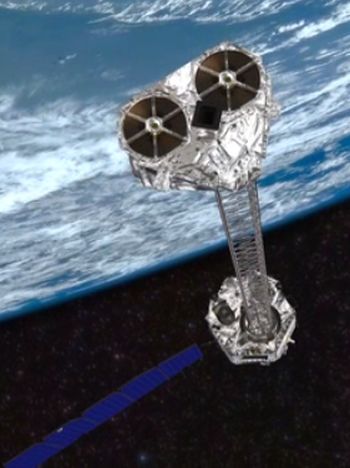NuSTAR Off To Explore Mysteries Of Black Holes
By Ed Pierce // June 13, 2012
Revealing Cosmic Secrets
(VIDEO: camillasdo)
BREVARD COUNTY • CAPE CANAVERAL, FLORIDA – A flying observatory equipped with X-ray vision to peer into Black Holes and other exotic space objects was launched this morning from an atoll in the Pacific Ocean.

NASA’s NuSTAR mission was launched from a Pegasus XL rocket, carried by an Orbital Science Corporation L-1011 “Stargazer” plane taking off from the Kwajalein Atoll in the Pacific, about noon today.
Some five seconds or so before the launch, the Pegasus XL rocket dropped from the plane, ignite and lifting NuSTAR into space.
Low-cost mission
The NuSTAR program is a project of NASA’s Small Explorer program, which launches scientific missions at minimum expenditures.
Once in space, NuSTAR will separate from the Pegasus and the satellite’s system controlling its attitude will stabilize it and its solar arrays will be deployed.
Signals on the ground will be received from NASA’s Tracking and Data Relay Satellite System and over the next week NuSTAR’s mission staff will perform a series of tests to make sure all the satellite’s systems are operating nominally.
If all checks out, NuSTAR will then deploy its 33-foot boom and allow its telescope to focus X-ray light into sharp images.

In a press release, NASA says unlike visible-light telescopes, X-ray telescopes require a long distance between the mirrors and detectors to focus the light, similar to wearing glasses a few feet away from your face.
Answers possible
Through the use of high energy X-rays, NuSTAR could provide answers to a number of long-standing questions about space.
It might be able to tell how black holes are distributed through the cosmos, how heavy elements were forged in the explosions of massive stars and what powers the most extreme active galaxies.
NuSTAR’s primary objectives will include conducting a census for black holes on all scales using wide-field surveys of extragalactic fields and the galactic center; mapping radioactive material in young supernova remnants; studying the birth of the elements to understand how stars explode; observing relativistic jets found in the most extreme active galaxies and understanding what powers giant cosmic accelerators.
NASA says NuSTAR also will examine the origin of cosmic rays and the extreme physics around collapsed stars while responding to targets of opportunity including supernovae and gamma-ray bursts.












